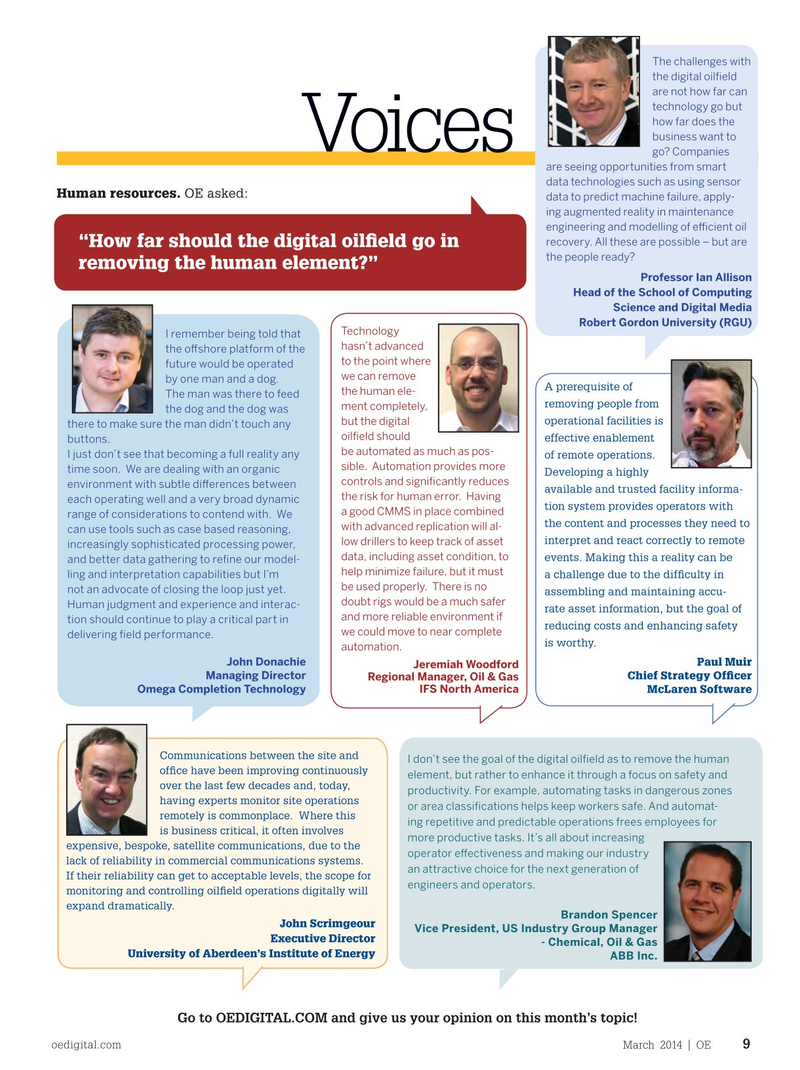
Page 7: of Offshore Engineer Magazine (Mar/Apr 2014)
Read this page in Pdf, Flash or Html5 edition of Mar/Apr 2014 Offshore Engineer Magazine
The challenges with the digital oilfeld are not how far can technology go but how far does the business want to Voices go? Companies are seeing opportunities from smart data technologies such as using sensor
Human resources. OE asked: data to predict machine failure, apply- ing augmented reality in maintenance engineering and modelling of efcient oil recovery. All these are possible – but are “How far should the digital oilfeld go in the people ready? removing the human element?”
Professor Ian Allison
Head of the School of Computing
Science and Digital Media
Robert Gordon University (RGU)
Technology
I remember being told that hasn’t advanced the ofshore platform of the to the point where future would be operated we can remove by one man and a dog.
A prerequisite of the human ele-
The man was there to feed removing people from ment completely, the dog and the dog was but the digital operational facilities is there to make sure the man didn’t touch any oilfeld should effective enablement buttons.
be automated as much as pos-
I just don’t see that becoming a full reality any of remote operations. sible. Automation provides more time soon. We are dealing with an organic
Developing a highly controls and signifcantly reduces environment with subtle diferences between available and trusted facility informa- the risk for human error. Having each operating well and a very broad dynamic tion system provides operators with a good CMMS in place combined range of considerations to contend with. We the content and processes they need to with advanced replication will al- can use tools such as case based reasoning, interpret and react correctly to remote low drillers to keep track of asset increasingly sophisticated processing power, data, including asset condition, to events. Making this a reality can be and better data gathering to refne our model- help minimize failure, but it must ling and interpretation capabilities but I’m a challenge due to the diffculty in be used properly. There is no not an advocate of closing the loop just yet. assembling and maintaining accu- doubt rigs would be a much safer
Human judgment and experience and interac- rate asset information, but the goal of and more reliable environment if tion should continue to play a critical part in reducing costs and enhancing safety we could move to near complete delivering feld performance.
is worthy.
automation.
John Donachie Paul Muir
Jeremiah Woodford
Managing Director Chief Strategy Offcer
Regional Manager, Oil & Gas
IFS North America Omega Completion Technology McLaren Software
Communications between the site and
I don’t see the goal of the digital oilfeld as to remove the human offce have been improving continuously element, but rather to enhance it through a focus on safety and over the last few decades and, today, productivity. For example, automating tasks in dangerous zones having experts monitor site operations or area classifcations helps keep workers safe. And automat- remotely is commonplace. Where this ing repetitive and predictable operations frees employees for is business critical, it often involves more productive tasks. It’s all about increasing expensive, bespoke, satellite communications, due to the operator efectiveness and making our industry lack of reliability in commercial communications systems. an attractive choice for the next generation of
If their reliability can get to acceptable levels, the scope for engineers and operators.
monitoring and controlling oilfeld operations digitally will expand dramatically.
Brandon Spencer
John Scrimgeour
Vice President, US Industry Group Manager
Executive Director - Chemical, Oil & Gas
University of Aberdeen’s Institute of Energy
ABB Inc.
Go to OEDIGITAL.COM and give us your opinion on this month’s topic!
oedigital.com March 2014 | OE 9 009_OE0314_voices.indd 9 2/21/14 11:17 AM

 6
6

 8
8